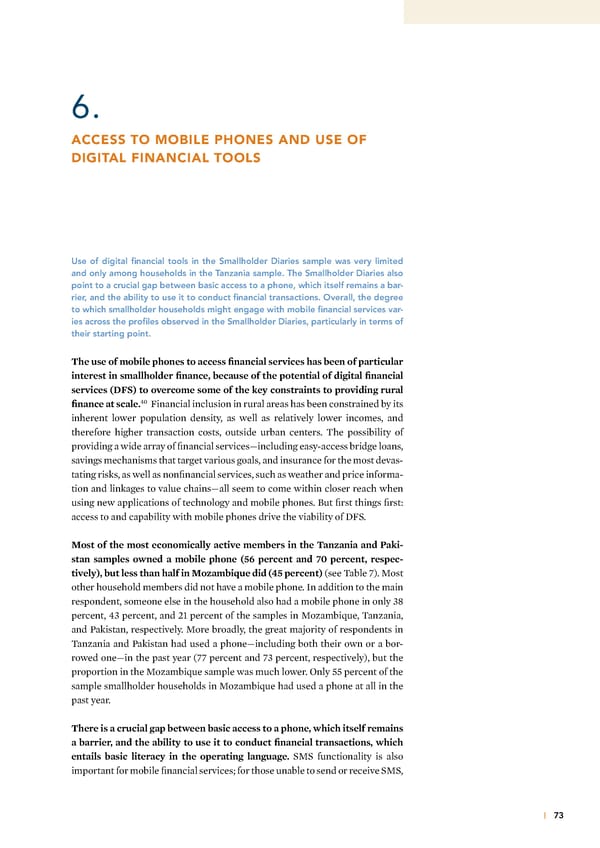6. ACCESS TO MOBILE PHONES AND USE OF DIGITAL FINANCIAL TOOLS Use of digital financial tools in the Smallholder Diaries sample was very limited and only among households in the Tanzania sample. The Smallholder Diaries also point to a crucial gap between basic access to a phone, which itself remains a bar- rier, and the ability to use it to conduct financial transactions. Overall, the degree to which smallholder households might engage with mobile financial services var- ies across the profiles observed in the Smallholder Diaries, particularly in terms of their starting point. he use of mobile phones to access financial serices has been of particular interest in smallholder finance, because of the potential of digital financial serices (DFS) to oercome some of the ƒey constraints to proiding rural “’ finance at scale inancial inclusion in rural areas has been constrained by its inherent lower population density, as well as relatively lower incomes, and therefore higher transaction costs, outside urban centers Œhe possibility of providing a wide array of financial services—including easy-access bridge loans, savings mechanisms that target various goals, and insurance for the most devas- tating riss, as well as nonfinancial services, such as weather and price informa- tion and linages to value chains—all seem to come within closer reach when using new applications of technology and mobile phones £ut first things first access to and capability with mobile phones drive the viability of ‰S ost of the most economically actie members in the anania and ‚aƒi- stan samples owned a mobile phone (˜œ percent and žŸ percent, respec- tiely), but less than half in oambi ue did (¡˜ percent) (see Œable •) –ost other household members did not have a mobile phone €n addition to the main respondent, someone else in the household also had a mobile phone in only Ÿ¡ percent, “Ÿ percent, and ‘… percent of the samples in –o—ambiue, Œan—ania, and aistan, respectively –ore broadly, the great ma„ority of respondents in Œan—ania and aistan had used a phone—including both their own or a bor- rowed one—in the past year (•• percent and •Ÿ percent, respectively), but the proportion in the –o—ambiue sample was much lower ¦nly ”” percent of the sample smallholder households in –o—ambiue had used a phone at all in the past year here is a crucial gap between basic access to a phone, which itself remains a barrier, and the ability to use it to conduct financial transactions, which entails basic literacy in the operating language S–S functionality is also important for mobile financial services for those unable to send or receive S–S, | 73
 Financial Diaries with Smallholder Families Page 90 Page 92
Financial Diaries with Smallholder Families Page 90 Page 92